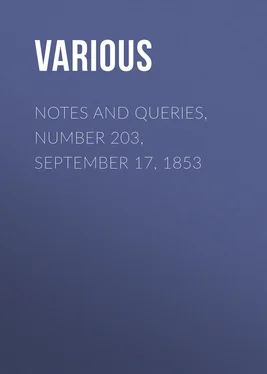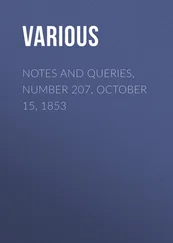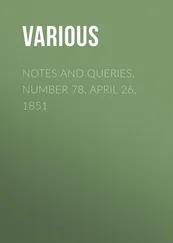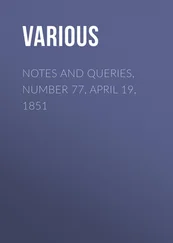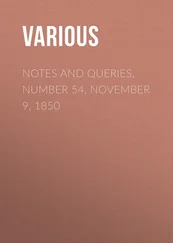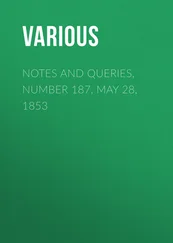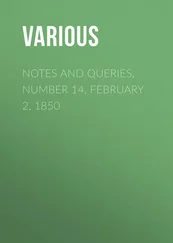Various - Notes and Queries, Number 203, September 17, 1853
Здесь есть возможность читать онлайн «Various - Notes and Queries, Number 203, September 17, 1853» — ознакомительный отрывок электронной книги совершенно бесплатно, а после прочтения отрывка купить полную версию. В некоторых случаях можно слушать аудио, скачать через торрент в формате fb2 и присутствует краткое содержание. Жанр: foreign_antique, periodic, foreign_edu, на английском языке. Описание произведения, (предисловие) а так же отзывы посетителей доступны на портале библиотеки ЛибКат.
- Название:Notes and Queries, Number 203, September 17, 1853
- Автор:
- Жанр:
- Год:неизвестен
- ISBN:нет данных
- Рейтинг книги:3 / 5. Голосов: 1
-
Избранное:Добавить в избранное
- Отзывы:
-
Ваша оценка:
- 60
- 1
- 2
- 3
- 4
- 5
Notes and Queries, Number 203, September 17, 1853: краткое содержание, описание и аннотация
Предлагаем к чтению аннотацию, описание, краткое содержание или предисловие (зависит от того, что написал сам автор книги «Notes and Queries, Number 203, September 17, 1853»). Если вы не нашли необходимую информацию о книге — напишите в комментариях, мы постараемся отыскать её.
Notes and Queries, Number 203, September 17, 1853 — читать онлайн ознакомительный отрывок
Ниже представлен текст книги, разбитый по страницам. Система сохранения места последней прочитанной страницы, позволяет с удобством читать онлайн бесплатно книгу «Notes and Queries, Number 203, September 17, 1853», без необходимости каждый раз заново искать на чём Вы остановились. Поставьте закладку, и сможете в любой момент перейти на страницу, на которой закончили чтение.
Интервал:
Закладка:
This opinion will no doubt offend many of those blind worshippers of Shakspeare, who will not believe that he could have written a passage which is not perfect, and who, consequently, will not be satisfied with any note, emendation, or restoration which does not make the passage into which it is introduced "one entire and perfect chrysolite." But this is unreasonable. We have direct evidence of the imperfect character of much that Shakspeare wrote. When told that Shakspeare had never blotted a line, Ben Jonson—no mean critic, and no unfriendly one—wished he had "blotted a thousand." Would rare Ben have uttered such a wish ignorantly and without cause? We believe the existence of such defects in the writings of Shakspeare, as they were left by him. It follows, therefore, that in our opinion Shakspeare is under great obligations to the undeservedly-abused commentators. 3 3 One of the most specious arguments which have been advanced against the genuineness of the Notes and Emendations is, that they agree in many instances with readings which had been suggested many years before the discovery of the MS. Notes. Of course it is obvious that, wherever the readings are right, they must do so; and these coincidences serve to satisfy us of the correctness of both.
It would be strange indeed, when we consider how many men of genius and learning have busied themselves to illustrate his writings, if none of them should have caught any inspiration from his genius. We believe they have done so. We believe Theobald's "babbled o' green fields" to be one of many instances in which, with reference to some one particular passage, the scholiast has proved himself worthy of and excelling his author. Yes, Shakspeare, the greatest of all uninspired writers, was but mortal; and his worshippers would sometimes do well bear in mind that their golden image had but feet of clay.
Notes
MR. PEPYS AND EAST LONDON TOPOGRAPHY, ETC
In "N. & Q." (Vol. i., p. 141.) there appeared an article upon the Isle of Dogs, &c., which spoke of the neglected topography of the east of London, and requested information on one or two points. Having felt much interested in this matter, I have endeavoured to obtain information by personal investigation, and send you the following from among a mass of Notes:—
1. Isle of Dogs. In a map drawn up in 1588 by Robert Adams, engraved in 1738, this name is applied to an islet in the river Thames, still in part existing, at the south-west corner of the peninsula. From this spot the name appears to have extended to the entire marsh.
2. Dick Shore , Limehouse. This is now called Duke Shore , Fore Street. In Gascoyne's Map of Stepney, 1703, it is called Dick Shoar . Since that time Dick has become a Duke . Mr. Pepys would find boats there now if he visited the spot.
3. Mr. Pepys, in his Diary of Mar. 23, 1660, speaks of "the great breach," near Limehouse. The spot now forming the entrance to the City Canal or South Dock of the West India Dock Company was called "the breach," when the canal was formed.
4. July 31, 1665. Mr. Pepys speaks of the Ferry in the Isle of Dogs. This ferry is named as a horse-ferry by Norden in the Britanniæ Speculum , 1592 (MS.). The ferry is still used, but only seldom as a horse-ferry.
5. Oct. 9, 1661. Mr. P. mentions Captain Marshe's, at Limehouse, close by the lime-house. There is still standing there a large old brick house, which may be the same; and the lime-kiln yet exists, for, as Norden says, "ther is a kiln contynually used."
6. Sept. 22, 1665. Mr. P. speaks of a discovery made "in digging the late docke." This discovery consisted of nut trees, nuts, yew, ivy, &c., twelve feet below the surface. Johnson no doubt told him the truth. The same discovery was made in 1789, in digging the Brunswick Dock, also at Blackwall, and elsewhere in the neighbourhood.
This very week (Aug. 25, 1853) I procured specimens of several kinds of wood, with land and freshwater shells, from as great a depth in an excavation at the West India Docks; the wood from a bed of peat, the shells from a bed of clay resting upon it. There exists an ancient house at the dock which Mr. P. visited, and which is probably the same.
Other illustrations of the Diary from this quarter might be adduced; let these, however, suffice as a specimen.
It may probably be new to most of your readers, as it is to me, that an ancient house in Blackwall (opposite the Artichoke Tavern) is said to have been the residence of Sebastian Cabot at one time, and at another that of Sir Walter Raleigh . Whether the tradition be true or not, the house is very curious, and worth a visit, if not worthy of being sketched and engraved to preserve its memory. Perhaps the photograph in this case could be applied.
It is not impossible that Sir John de Pulteney or Poultney, to whom the manor of Poplar was granted in the 24th of Edward III., resided on this spot. My reasons for thinking it are—this fact, which connects him with the neighbourhood; and the inference from two other facts, viz. that the house in which Sir John resided in town was called Cold Harbour , and that Cold Harbour is here also to be found. Sir John Pulteney is thus connected with both the places known by this name.
I would give my name in verification, but you have it, as you should have the names and addresses of all your correspondents.
B. H. C.Poplar.
PICTS' HOUSES IN ABERDEENSHIRE
A short time ago, one of those remarkable remains of a very remote antiquity, and called by the country-people Picts' Houses, Yird, Eirde, or Erde houses, was discovered by Mr. Douglass, farmer, Culsh, in the parish of Tarland, Aberdeenshire, near his farm-steading, on the property of our noble Premier. It is a subterranean vault, of a form approaching the semicircular, but elongated at the farther end. Its extreme length is thirty-eight feet; its breadth at the entrance a little more than two feet, gradually widening towards the middle, where the width is about six feet, and it continues at about that average. The height is from five and a half to six feet. The sides are built with stones, some of them in the bottom very large; the roof is formed of large stones, six or seven feet long, and some of them weighing above a ton and a half. They must have been brought from the neighbouring hill of Saddle-lick, about two miles distant, being of a kind of granite not found nearer the spot. The floor is formed of the native rock (hornblende), and is very uneven. When discovered it was full of earth, and in the process of excavation there was found some wood ashes, fragments of a glass bottle, and an earthenware jar (modern), some small fragments of bones, and one or two teeth of a ruminant animal, and the upper stone of a querne (hand-corn-mill, mica schist), together with a small fragment, probably of the lower stone. But, alas! there were no hieroglyphics or cuneiform inscriptions to assist the antiquary in his researches. These underground excavations have been found in various parishes in Aberdeenshire, as well as in several of the neighbouring counties. In the parish of Old Deer, about fifty years ago, a whole village of them was come upon; and about the same time, in a den at the back of Stirlinghill, in the parish of Peterhead, one was discovered which contained some fragments of bones and several flint arrow-heads, and battle-axes in the various stages of manufacture. In no case, however, have any of those previously discovered been of the same magnitude as the one described above. They were generally of from twelve to fifteen feet in length, and from three to four feet in height, and some only six feet in length, so that this must have been in its day (when?) a rather aristocratic affair. Have any similar excavations been found in England? The earliest mention of the parish of Tarland, of which there is any account, is in a charter granted by Moregun, Earl of Mar, to the Canons of St. Andrews, of the Church of S. Machulnoche (S. Mochtens, Bishop and Confessor) of Tharuclund, with its tithes and oblations, its land and mill, and timber from the Earl's woods for the buildings of the canons, A.D. 1165-71; and a charter of King William the Lion, and one of Eadward, Bishop of Aberdeen, both of same date, confirming the said grant.
Читать дальшеИнтервал:
Закладка:
Похожие книги на «Notes and Queries, Number 203, September 17, 1853»
Представляем Вашему вниманию похожие книги на «Notes and Queries, Number 203, September 17, 1853» списком для выбора. Мы отобрали схожую по названию и смыслу литературу в надежде предоставить читателям больше вариантов отыскать новые, интересные, ещё непрочитанные произведения.
Обсуждение, отзывы о книге «Notes and Queries, Number 203, September 17, 1853» и просто собственные мнения читателей. Оставьте ваши комментарии, напишите, что Вы думаете о произведении, его смысле или главных героях. Укажите что конкретно понравилось, а что нет, и почему Вы так считаете.
